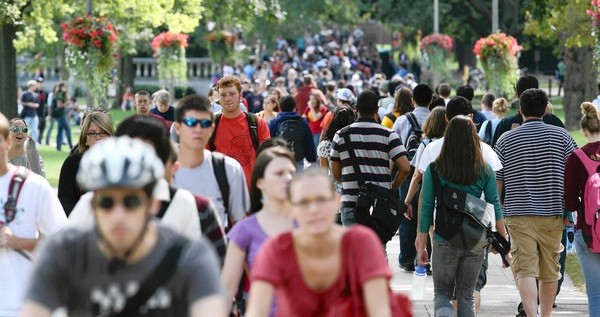Student Loan Debt A Growing Threat To The Economy

$870 billion in outstanding balances exceeds credit card, auto obligations
Move over, mortgages. Get out of the way, Greece. Another economic doomsday scenario is emerging.
Student loan debt has reached about $870 billion, exceeding credit cards and auto loans, and balances are expected to continue climbing, the Federal Reserve Bank of New York said last month. In February, the National Association of Consumer Bankruptcy Attorneys referred to a “student loan ‘debt bomb’” and wondered if it was shaping up to become “America’s next mortgage-style economic crisis.” Such a burden could crimp an already weak economy.
“Student debt poses a large and growing threat to the stability of our economy,” Illinois Attorney General Lisa Madigan testified March 20 before a U.S. Senate judiciary subcommittee hearing in Washington on the looming student debt crisis.
“Just as the housing crisis has trapped millions of borrowers in mortgages that are underwater, student debt could very well prevent millions of Americans from fully participating in the economy or ever achieving financial security,” Madigan said.
In January, Madigan’s office sued for-profit Westwood College, claiming it misleads students enrolled in its criminal justice program, puts them deep in debt and awards a nearly worthless degree. She told the Senate last month that since filing the suit, 1,000 former and current Westwood students have come forward to complain about their experiences.
A spokesman for Westwood said Thursday that a motion to dismiss the case is pending.
The hearing was convened by Sen. Dick Durbin, D-Ill., who is pushing legislation, the Fairness for Struggling Students Act, which would allow students who borrowed from private lenders for their education to wipe out that debt in bankruptcy proceedings, just as credit card borrowers and many other unsecured debtors may do. In 2005, Congress changed bankruptcy laws and made private student loan debts nondischargeable in bankruptcy, with few exceptions.
“It’s clear that too many students have been steered into loans that they will not be able to repay and that they will never be able to escape,” Durbin said.
Private student loans often carry higher and variable interest rates and fewer consumer protections than government loans, which are more likely to offer interest rate caps, loan limits, income-based repayment plans and forbearance in times of economic hardship.
“While the overall growth in student indebtedness is troubling, the most pressing concern is private student loans,” Durbin said. “Private student loans are a riskier way to pay for an education than federal loans.”
Under Durbin’s legislation, students would remain responsible for repaying government-issued or guaranteed student loans and would be unable to discharge those in bankruptcy.
Current bankruptcy law treats financially distressed students the same way as people trying to wiggle out of child-support debts, alimony, overdue taxes and criminal fines, Deanne Loonin, lawyer for the National Consumer Law Center, said at the hearing.
Danielle Jokela, 32, who lives in Rogers Park, testified that having the option to clear away student debt in bankruptcy would give borrowers a chip to negotiate with lenders. Currently, she said, there is no incentive for lenders to work with financially strapped borrowers.
Jokela said she does feel she bears some responsibility for her student debt of $98,000.
“I don’t want someone to wipe my debt clean, but I just want my lender to be reasonable and work with me,” she said in an interview.
Others argue against allowing student borrowers to discharge their private loan obligations in bankruptcy court. For one thing, if lenders knew borrowers could escape repayment through bankruptcy, they might raise interest rates to account for that risk and lend to fewer people.
It would “result in a dramatic increase in the cost of student loans for all borrowers, ultimately drying up the availability of such loans for those who need them most,” testified Marcus Cole, a Stanford University law professor. He called it an “unjust transfer from innocent lenders who did nothing more than give money to people in hopes of being repaid someday.”
It could also encourage students to be careless about the debt they take on, said Neal McCluskey, associate director for the Cato Institute’s Center for Educational Freedom.
“Students might be more apt to take such loans if they think that they will be able to unload their debt without repaying it,” he said.
However, student lender Sallie Mae supports reform that would allow federal and private student loans to be dischargeable in bankruptcy for those who have made a good faith effort to repay their loans over a five-to-seven-year period and still experience financial difficulty, agency spokeswoman Martha Holler said.




